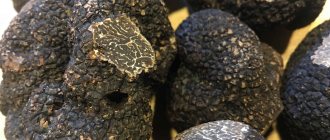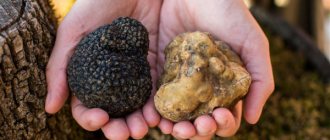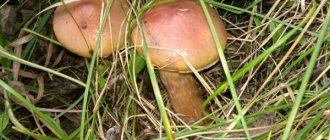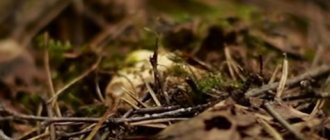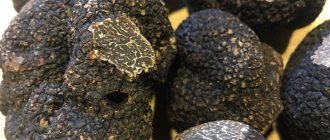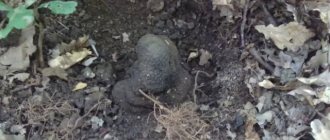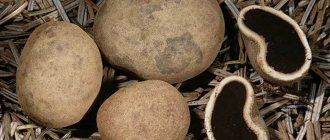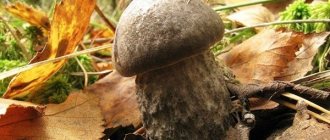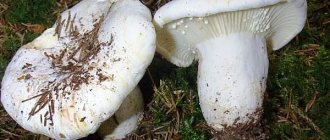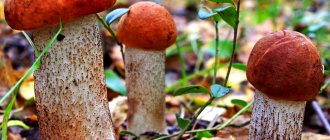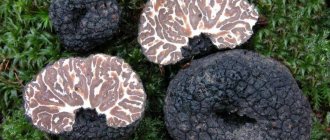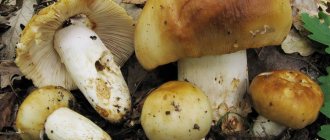Truffle mushroom is the most expensive mushroom and delicacy on the planet. Grows underground. They often look for him in the forest, as if on a hunt, with dogs. In general, the culinary diamond is shrouded in many secrets and conventions. In this article I will answer the most popular questions about the rare mushroom: where does the truffle grow, what does it look like, what does it smell like (yes, the smell is specific, but magical). This is a detailed, and therefore long, description of the truffle mushroom. If you are interested in a specific question, click on the desired line of interactive content and go to the appropriate section.
Content
- Description of the truffle mushroom, what it smells like General information
- What does a truffle look like?
- What does truffle smell like?
- What does fresh truffle taste like?
- When did truffles begin to be cultivated?
- Price for black truffle
- How to cook truffles
When to collect
Summer truffles can be collected in July and August, winter ones - in September. In this case, mushroom pickers get very beautiful fruits. For collection, special baskets or wicker baskets made of twigs are used. The legs of truffles are usually short, but there are specimens in which they reach 20 cm. It is advisable to collect only fresh mushrooms; you should not take wrinkled or damaged ones.
You only need to cut off the lower part of the stem, and treat the cut with a knife for safety - the mushroom can hurt. If the specimen is very large, you can cut off the top part, but you need to leave the long stem in the ground on which the mushroom is located. The selected fruits must be processed immediately, even if there are only a few of them. When harvesting, truffles are not washed, as they absorb contaminants from the air, so the caps must be thoroughly cleaned of dirt and sand. And during processing, it is recommended not to wash, but only wipe with a damp cloth.
Truffles cannot be collected in urban areas, near highways or industrial enterprises. The surface of such mushrooms contains salts of heavy metals and other harmful substances that can negatively affect the taste. In addition, pollinating insects are often present in urban environments and destroy truffles. The place where the mushroom was found should be hidden from prying eyes, for example, by putting up a canopy, making a hut from branches, or placing it in a basket or box covered with a soft cloth.
Description of the truffle mushroom, what it smells like
general information
Truffle is the most mysterious mushroom in the world. He hides from human eyes and lives underground. Scientists are still arguing about how many species this marsupial fungus has. Some say 70, others 100. They agreed on one thing: truffles are both edible and inedible. We’ll talk about habitats a little later, now I’m just warning you: the truffles that scientists found in Belovezhskaya Pushcha cannot be collected.
What does a truffle look like?
If we are talking about truffles, which chefs sigh for, then they come in white and black. I saw only a black truffle with my own eyes. Therefore, I will sweeten the description of the mushroom with my personal impression.
It was the size of an apricot. The body of the mushroom, or more correctly the tuber or sac, is “covered” with an elastic crust. It reminds me of a walnut shell.
The size (black and white) depends on age and can be either the size of a nut or the size of a large potato. Or even beets.
The diameter varies from 1 to 20 cm, the weight ranges from 5 to 1500 g. Yes, this is possible, an underground mushroom can weigh 1.5 kg.
The skin is dense, uneven, with cracks and “moles.” The white truffle has a white-brown, ocher color. Black has a complex combination, where red-brown, blue and black colors are mixed.
The flesh of a fresh truffle is light in color and has a marble-like pattern. Then it will darken to brown or even burgundy-black, become more flabby, the pattern of the veins will fade, but will not go away. The pattern inside the truffle is plates with spores.
What does truffle smell like?
One truffle “smells” like rotten wood. To others - spoiled onions. But a strange thing happens: the smell seems unpleasant, but it’s not disgusting either. Unusual - yes. Incomparable to anything - yes. Indescribable. But definitely not annoying. Androstenone gives truffles a specific aroma.
But still: what does a black truffle (or Périgord truffle, since it grows in France) smell like? Imagine the smell of the autumn forest, when the leaves have fallen and become wet from the rains. And add to this smell the aroma of roasted walnuts. Others find that black truffle smells like seaweed. To me, there is something woody, foresty and a little... really something rotten in the aroma of the black king.
Tired of reading? A short biography of the truffle is available at this link.
The most valuable type is the Italian (Piedmontese) truffle. The simple name is true white (not to be confused with white, also known as Trinity, Polish, which is considered poisonous in Italy). Piedmontese white truffle resembles Jerusalem artichoke tubers. As a rule, it does not grow more than 300 g and 12 cm in diameter. There are, of course, rare kilogram specimens. But this is the exception rather than the rule. A real white truffle is extremely aromatic and smells close to... cheese with garlic.
Description and appearance
The truffle is covered with peridium - an outer covering layer with a huge number of warts or cracks - which in certain varieties is almost white. When cut, the internal flesh resembles marble, consisting of external and internal veins of different shades. In the latter, the sacs with spores mature, and they are lighter than the outer ones. The shade of the pulp of different types is not the same.
Based on the species description, the aroma of truffles is characterized by the following set: the smell of rotten leaves, autumn forest, ripe fruit, humus and even cocoa and chocolate. The flavor of these mushrooms is nutty, similar to roasted seeds, and it has a coconut, chocolate, or fruity aftertaste. The heat treatment of these amazing mushrooms is minimal.
Gourmets recommend eating truffles raw so as not to lose their true aroma and unique taste. Mushrooms sent for storage lose most of their properties.
Truffle is used as a seasoning for various dishes, pairing perfectly with steaks and poultry, omelettes and pasta. It can be an ingredient in sauces, fillings, and delicious pates. The calorie content of mushrooms is low - 100 grams contain 51 kcal, but they differ in a number of useful properties. They contain vitamins B1, B2, C, PP, essential amino acids, and these mushrooms were also previously used as an aphrodisiac.
Why do truffles smell so unusual? It turns out that everything is simple: the aroma of mushrooms attracts wild boars, badgers and foxes. By digging up the tubers, animals release the pores of the fungi, which the latter use to reproduce. It is precisely this mechanism that guarantees the survival of the species.
Where does the truffle mushroom grow?
They call it truffles. Both a black diamond and a white diamond. Even an underground king. Yes, the life of a gourmet idol takes place underground. Truffles grow at a depth of up to 30 cm. They rarely appear outside. This happens with old, that is, large, specimens.
Truffle is not an independent mushroom. It feeds on adjacent trees. “Sticking” to the roots, it consumes carbohydrates from its stronger neighbors. But he is not selfish - and generously thanks for the help: sharing water and protecting trees from microbes.
The most powerful aroma comes from mushrooms that grow under oak trees.
Most “underground diamonds” of black color choose hazel, oak, beech, and hornbeam as their neighbors. Whites prefer birch, hawthorn, elm, linden, poplar, rowan, and willow trees.
Silent hunt
Detecting mushrooms requires some knowledge. They adore the moist black earth soil, and the smell reaches its climax at night. Nuances you should know:
- Near truffle deposits there is always stunted vegetation and gray-ashy soil.
- Remember about the deep location, so dig out all the mounds you encounter.
- Over the rich location there is a cluster of a swarm of red midges, laying eggs here.
- They take with them trained dogs or pigs, which sense samples a couple of tens of meters away and clearly follow them, starting to dig.
Go into the forest with beech, birch, and oak trees, passing by clearings that are unsuitable for growth. If your assistant is a pig, put a muzzle on her, otherwise the prey will be immediately eaten.
Dig up the fruiting body carefully, ensuring that the remains continue to live.
The information provided will help you decide where the truffle grows and how to look for it.
How to find a truffle
How to find a truffle if it is completely immersed in earthen darkness? Go forest hunting in the fall. The first sure sign is swarming yellowish flies. It is worth looking for them near the named trees at sunset, when insects lay eggs and their larvae feast on mushrooms.
Trifolau, a professional truffle collector, goes searching with a specially trained dog. The animal detects the mushroom by a specific smell, which it can smell at a distance of 20 meters. Such dogs are used in Italy, France, Poland and other countries. Another way is to replace dogs with regular pigs. The pig also goes for the truffle. Only, unlike a dog, she will not just dig up a valuable mushroom, but can eat it.
Reindeer truffle. Distributed in Belarus, in France and Italy it is considered poisonous.
It is better to go out on a quiet hunt with a dog (or pig) at night. It is in the dark that the desired smell is most evident.
The truffle hunting season is November-December, but can last longer. Depends on the weather. But in Polesie there is a black summer truffle (sometimes called Russian). It is not as valuable as black, but similar to it. And it grows in summer.
The shelf life of the delicacy is only 2-4 days. In order not to damage the gastronomic jewel and not release the aroma, the find is transported in a container. Store in the refrigerator.
Note to those who are lucky enough to find a truffle, but who decide not to eat it right away. If you put the mushroom in dry sand or a dry, cool and always dark place, the shelf life can last up to 2 months.
For longer storage, you will have to cut it into pieces and add olive oil. This is the option that is often sold in stores.
Mushrooms can be frozen, dried, canned.
Why is it so valued?
Mushrooms contain many useful elements:
- antioxidants;
- vegetable proteins;
- pheromones;
- vitamins;
- alimentary fiber.
Substances that make up the product have therapeutic and preventive properties:
- Vitamin C strengthens the immune system, prevents the development of colon cancer and ensures complete absorption of iron and calcium;
- vitamin PP takes part in metabolic processes, regulates the level of bad cholesterol in the blood and prevents the occurrence of cardiovascular diseases;
- nicotinic acid increases the amount of estrogen and testosterone in the body, and also improves skin condition.
Mauro Maccarone from Rome's Campus Bio-Medico University found that truffle contains anandamide, a substance that has effects on the nervous system similar to marijuana.
Black truffle
What is unique about the food composition?
Truffle is a low-calorie product and if not for its exclusivity, it could become the basis of a fasting diet for many people losing weight. Its calorie content per 100 g is 24 kcal.
| The nutritional value | Quantity, g |
| Squirrels | 3,0 |
| Fats | 0,5 |
| Carbohydrates | 2,0 |
| Cellulose | 1,0 |
| Ash | 1,0 |
| Water | 90,0 |
Unlike ordinary mushrooms, the pulp of the “white diamond” is more easily absorbed by the body, restores the intestinal microflora and normalizes the acidity of the stomach.
| Chemical composition (per 100 g of product) | Amount, mg |
| Thiamine (vitamin B1) | 0,02 |
| Riboflavin (vitamin B2) | 0,4 |
| Nicotinic acid (vitamin B3) | 9,0 |
| Ascorbic acid (vitamin C) | 6,0 |
There are no restrictions on the intake of the mushroom, and elite restaurants serve dishes that contain no more than 10 g of the product.
Other habitats
Edible truffles historically grew in Polesie, Belovezhskaya Pushcha, and regions of Russia. You can find truffles even near Kyiv. Unfortunately, the tradition of cultivating and consuming truffles in Ukraine (as in Russia and Belarus) has died out. But in the middle of the 20th century, in the same Ukraine, edible truffles were actively growing, they were collected en masse and... sold to France.
Summer truffle. Grows in Belarus.
In Belarus, all types of truffles growing are listed in the Red Book.
If you decide to organize a truffle hunt, mark: the landing place is the departments of Lot and Doldogne in France. This is where gourmets from all over the world come in the fall to find elite black truffles.
It is useless to ask local residents “about the fishing spot: no one will give you secret information, or maybe, as in the story with Ivan Susanin, they will completely send you on the wrong trail. The truffle deposit is a mystery that, in addition to the emotional one, has a commercial explanation.
Interesting information
Unique specimens were first mentioned in written sources of 1600-1700. BC e. In the Middle Ages they were credited with magical powers. The ancient Romans baked them over coals and ate them with honey, which was believed to enhance libido.
According to the current hypothesis, mature samples contain a molecule of happiness, anandamide, which is a psychotropic substance that improves mood. In addition, the fragrant smell is a strong aphrodisiac.
- In the 19th century, 1000 tons of product were collected, today production has decreased to 50 thousand.
- China is a major manufacturer; its products are cheaper, but not of good quality.
- Holding Italian autumn truffle fairs in Alba has become a tradition that annually brings together gourmets from all over the planet.
- The largest edible giant gained a mass of almost 2 kg.
Photos of places where truffles grow confirm that they prefer deciduous or mixed forests and groves with conifers. Exotics are listed in the Russian Red Book.
Truffle taste
What does fresh truffle taste like?
If you ask if there are strange-tasting mushrooms, I will say: “Yes, there is one. Monsieur truffle." Surprisingly, the taste and aroma of truffle are inextricably linked. Therefore, when we talk about taste, we should definitely remember the smell.
I wrote above that truffles emit the smell of rotting wood. To be more precise: wet tree bark mixed with forest litter. The smell is rare and strange for food, but in some miraculous way it hypnotizes a person and promotes the production of gastric juice. Unprecious, inedible, truffles smell like rotten onions or herring.
This is what a false truffle looks like. It cannot be eaten.
The taste itself is difficult to describe, since the woody smell commands during the tasting. The truffle is not sour, not salty, hard and therefore crunches when chewed. There are no hints of spice in it. It is almost neutral (if you hold your nose).
It is better to cut the truffle before eating. When you release the mushroom from the “cocoon”, the stubborn aroma begins to spread throughout the room. Quickly fills space. The festival of taste begins. Some chefs claim that the strong smell can give you a headache.
Along with France, Bulgaria and Spain, one of the main suppliers of truffles in the world is Italy. It is in Italy that Accademia del Tartufo operates. There they grow, study and improve their preparation of truffles.
Every year on November 9, the White Truffle Festival is held in Italy.
Students of this educational institution are given the opportunity to hunt truffles and experiment with their preparation technologies. As a rule, chefs and gastronomic enthusiasts study at the academy.
What wine to drink with truffle
Truffles are good to taste with wine. Wine must be chosen according to the principle of locality: where the mushroom grows, the grape alcoholic drink comes from there.
The best solution is a single variety! Experts advise sticking with nebbiolo. This red wine variety comes from Piedmont, a region of Italy where the country's best truffles are harvested. The demonic aroma and taste of truffle is revealed by aged Sangiovese and French (Burgundy) Pinot Noir.
Use in cooking
These unique mushrooms are used in a variety of dishes as they can complement almost any flavor. But it is best to use neutral additives that will not overshadow the special taste of mushrooms. Most often they are used for:
- sauces;
- pastes;
- rice;
- seafood;
- birds.
At the same time, the dish requires a minimum amount of expensive mushrooms, as they have a very bright taste.
In fact, truffles are parasites that feed on tree roots, although they do not harm plants. They are famous, among other things, because their taste and smell make such a powerful impression that it is impossible to forget them. It is believed that the aroma of truffles is a full spectrum of all those smells that we love so much in the autumn forest: the aroma of wet trees, the smell of foliage, musky notes and fresh earth, and all this is absorbed by the truffle, intensifying it significantly. The aroma of mushrooms is extremely strong, which is why they are used little by little.
Why truffles are better than other mushrooms: beneficial properties
Thanks to its specific smell, truffles were dug up and eaten in Antiquity. At that time, the mushroom was considered a remedy for eye diseases and as a “pill” for normalizing blood flow.
The truffle received a new interpretation during the Renaissance, when it was ranked among the most powerful aphrodisiacs.
On the one hand, truffle increases the sensitivity of certain areas of a person. On the other hand, it calms the nervous system. Isn't it strange? But he is so contradictory, this little marsupial dictator.
I’ll finish the topic of the beneficial properties of truffle: it strengthens the immune system, has a beneficial effect on the microflora of the gastrointestinal tract. An excellent antioxidant. Low-calorie, therefore recommended for overweight people.
Places of production of the top 6 types of truffle
- The most valuable is white
- Istria (Slovenia, Croatia),
- Italy(Tuscany, Piedmont, Umbria)
- Cato Ticino Switzerland in extremely rare cases
Fruits from September to January at temperatures below 10 degrees Celsius.
Dimensions from 2 to 6 cm. Rarely reaches 15. It grows at shallow depths and is mined only with the help of a special shovel.
- Winter black (precious)
- Historical areas - Provence and Périgord (Dortagne - southwest of the country)
- Italy has regions such as Umberia, Campania, Piedmont and Tuscany. In rare cases, other regions
- Aragon region in Spain
- Part of Croatian Istria
This mushroom bears fruit from November to mid-March. Has compact external data.
How do truffles grow?
When did truffles begin to be cultivated?
White truffles have not yet been grown in an artificial environment. The stubborn black truffle resisted for several centuries. But he still gave up: in 1808, J. Talon planted acorns and a few years later he found mushrooms nearby.
The French repeated the experiment in 1847, planting 7 hectares with acorns. By the end of the 19th century, about 750 “square” kilometers of truffle forest were established in the country.
The largest truffle was found in San Miniato, weighing 2.5 kg.
It is believed that truffle farming is one of the most leisurely branches (along with snail breeding) of agriculture. The first harvest may “hatch” in ten years.
Truffles are capricious and vulnerable to changes in weather. Therefore, there are few of them left in the natural environment. But truffle farms operate successfully all over the planet: China, North America, New Zealand and even Australia.
About half of the “Italian” (ie white) and about a third of the “French” (ie black) truffles are collected in the forests of Bulgaria. All edible Piedmontese and Perigord species can be found there. In January 2016, tourist trips are being organized for lovers of exotic culinary experiences in Bulgaria.
Do not confuse: truffle is a tomato variety
Truffle mushroom is often confused with truffle candy, a sweet chocolate “drop”. But few people not involved in gardening know about a tomato variety called truffle.
Truffle tomatoes look like truffle mushrooms (hence the name). The variety was developed by Russian breeders. Comes in five colors. On average, the fruit weighs 90-170 grams, the yield per bush is about 4 kg.
Grow truffles at home
Can. If you bookmark it correctly and be patient. The minimum period for the appearance of the first mushrooms is 6 years. On average, culinary extremes harvest their first harvest after 10 years.
What truffles like:
- warm climate (mild winters, humid, cool summers);
- the area is protected from strong winds and scorching sun, moderately moistened;
- do not plant mushrooms on land previously used for agricultural crops;
- the best option for mushroom “beds” is an oak forest;
- ideal soil acidity is 7.9 (resistant to water erosion, loose, with lime, an admixture of clay, rich in humus, nitrogen and calcium).
A Step-by-Step Guide for the Gardener
- Oak seedlings need to be mycorrhized with black truffle. They are sold in specialty stores. You can treat the roots of young trees yourself with spores or fungal threads. For the mycelium to take root, keep it in quarantine for two weeks. Then (ideally) plant them in a ventilated greenhouse, at a temperature of 16.5–22°C, with low humidity, until they grow to 30 cm.
- Plant in the warm season (so that the daytime temperature is above 16.5°C). Remove competing mushrooms, weeds, and plow the soil. Do not fertilize.
- Distribute trees according to the principle: 5 holes per hundred square meters. The depth of the hole is up to 75 cm. Water, sprinkle with soil, water. Within a radius of 50 cm of each seedling, oak leaf litter (up to 10 cm) is mulched. Cover with film.
- For the first two years, make sure that the developing mycelium is not attacked by pests, weeds, rodents, and pigs. Control the acidity of the soil, sprinkle the area around the trees with ash, crushed tree bark, and lime.
- No chemistry. You can spray the soil with a solution of water and ammonium glufosinate (200-300 l/ha) in a ratio of 1:100.
- Feed the trees with a complex of microelements with a nitrogen-phosphorus-potassium composition. If cracks appear, sprinkle with dry (clean!) sand.
- For the winter, cover the ground around the trees with leaves. Trim tree branches and trunks to a height of no more than 1 m. Do not allow the soil with mycelium to freeze below 5 °C.
- Mushrooms grow in autumn, the minimum development period is 4 months. That is, if the seedlings are planted in the spring, then the first harvest can be harvested in November. A mature black truffle will be black, an unripe one will have a reddish tint.
- Don't flatter yourself. On average, mycelium takes a year to take root in a new place. The first good harvest in your own garden, as a rule, is harvested after 3-4, or even 5 years.
- Having matured, the mycelium will produce more harvest.
- When the mushrooms have grown, they slightly lift the soil, forming mounds of dried grass. These are truffles. Dig carefully in these places according to the principle: at a depth of 20 cm, the mushrooms will be collected in a circle of 3-7 fruits. If you find a mushroom at a depth of less than 15 cm, check: it may be rotten.
- Dig up truffles like you would dig up potatoes, only more gently so as not to damage the mycelium.
Kinds
There are different types of this unique mushroom. There are more than a hundred varieties, but about ten are edible. Moreover, some poisonous and inedible species belong to other genera. What unites them is their way of life: both grow underground.
The following types are distinguished:
- Piedmontese or Italian white. In this family, these mushrooms are valued above others. They grow in some areas of Piedmont, in northern Italy. They are found in hilly areas near Turin, Langhe, Monferrato, Roero. Grows under poplar, oak, willow, and sometimes under linden. The truffle aroma is reminiscent of cheese and garlic, along with earthy and musky notes. A white truffle costs 3-4 thousand euros per kilogram.
- Perigordsky. This truffle is also called French black, and it is the second most valuable. Distributed in Spain, France, Central Italy. This variety is now grown artificially; it was brought to South Africa, Australia, and America. The mycelium of the fungus is comfortable under oak and deciduous trees. It has a nutty aroma, vaguely reminiscent of chocolate and nutmeg, and a spicy taste with a slight bitterness.
- Black winter. This species grows in Italy, Ukraine, France, Switzerland in moist soils. The mycelium prefers the roots of hazel and linden, beech and birch. These mushrooms have an intense musky odor.
- Black summer. Another name for this truffle is Russian. You can meet it in Central Europe, Russia, Scandinavia. It grows under hornbeam, beech, oak, and less commonly under pine and birch. The taste is distinguished by nutty notes, as well as the taste of algae.
- Black autumn. It is also called Burgundy. This species is valued somewhat lower than its French and Italian counterparts. It grows in the northeastern part of France, a little less often in Italy. The smell and taste are similar to hazelnuts with pronounced notes of chocolate.
- White Oregon. These truffles can only be found in the western regions of the United States. They are often located directly under the layer of needles. The taste of these mushrooms has a fruity and rich herbal accent.
- Himalayan. This type is also called Chinese. Nowadays, varieties of this truffle are cultivated artificially and supplied to all countries of the world. They cost less, since mushrooms are noticeably inferior in taste to Italian and French truffles. The Himalayan variety has a weak aroma and a lean taste.
- African, or steppe. This species is widespread in the Middle East, Turkmenistan, Azerbaijan, the Mediterranean, and North Africa. The mycelium forms mycorrhiza with herbs - cistus and sunflower. Truffles have a mushroom aroma.
- Red shiny. This species can be found in any European country, in mixed and deciduous forests. The mycelium is active with deciduous trees and conifers. This variety is a relative of the red truffle. The smell and taste are close to pear, red wine and coconut.
- Red. This species, common in Europe, is distinguished by the red color of its upper layer. It is characterized by low culinary value. The taste is meaty, sweetish with a coconut herbaceous undertone.
- White March. It grows in the southern part of Europe, including in the regions of Crimea. Young truffles have a rich mushroom aroma with garlic notes. Old mushrooms have a repulsive, unpleasant odor. This variety can be cultivated, but its price is low.
How much does a truffle cost?
White truffle price
Late autumn in Piedmont is a magical time. The best restaurants in this Italian city serve a special truffle menu. Pasta, appetizers, desserts - chefs add truffles to all sections of the menu. Dishes with fresh truffle are, of course, not cheap. The presence of a noble delicacy at least doubles the standard price tag. The price of the truffle itself depends on the type of mushroom (white is more expensive than black) and its weight. The most expensive truffle (and at the same time the most expensive delicacy in the world) is the white truffle from Alba, on the border with Piedmont. Mushrooms from these regions sell for 1.5-7.5 thousand euros per kilogram. More expensive than black caviar and gold.
White truffle is more expensive than black truffle.
In 2007, a valuable 1.5-kilogram copy was sold for 330 thousand US dollars.
Price for black truffle
No more than 10 percent of black truffles are selected for individual sale. The rest goes into processing - into truffle oil, sauces, dressings, carpaccio in olive oil.
In the supermarket, a whole truffle the size of a walnut, placed in a jar of olive oil, produced by Giuliano Tartufi, costs about 10 euros.
Black truffles are usually sold to order in expensive restaurants. Weight ranges from 30-100 g per piece. The larger, the more expensive, but large ones (the size of an orange) grow rarely, no more than 1 percent. About 10 percent of the harvest are truffles the size of nuts, 30 percent are the size of grapes. The rest are even smaller.
A kg of French black truffle costs 400-1200 euros per kilogram. It may be higher, depending on the size of the mushroom. Chinese truffles are not valued on the HoReCa market and are several times cheaper: 20 euros per kg.
The most expensive natural black truffle was sold at auction for 160 thousand US dollars.
Truffles are the most expensive mushrooms in the world because they are difficult to grow in an artificial environment and because their reproduction is almost impossible to influence.
Where to try truffles in Belarus
In Minsk, you can try truffles at the Michel cafe (Karl Marx St., 9). The sophisticated establishment serves a burger with truffle oil, beef patty and caramelized bacon. The meat giant costs 30 rubles.
In Brest, for truffles, go to the Venice cafe (5 Internatsionalnaya St.). Italian traditional bread - focaccia - is baked in the oven in full view of the guests. One option is with truffle oil. The divine bread costs 5 rubles per piece.
In Grodno, you can, unfortunately, only try truffles in the coffee shop of the Kommunarka confectionery factory. And they don’t sell truffle mushrooms... but sweets. Alas, I couldn’t find any restaurants or cafes serving dishes with truffles in Grodno.
Basic storage rules
Another feature inherent in truffles is their very short shelf life, and in order to feel the fullness of their taste, they must be consumed only fresh. That is why, as soon as the season comes and mushroom picking begins, they are sold out extremely quickly, to the point that auctions are held for mushrooms among restaurants and connoisseurs. However, these tubers can still be stored for some time: some of them are immersed in oil and then used in sauces as an addition. Sometimes mushrooms are placed in rice, sometimes even frozen, although such truffles are no longer so highly valued.
Recipes and ready-made dishes with truffle
How to cook truffles
Truffles can be combined with almost any food. With rice, vegetables (especially mashed potatoes), cheeses, eggs, fruits, meats, pasta and even desserts.
At the same time, the precious mushroom should not be frightened by sudden thermal changes. The truffle is heated for no more than 5 minutes and cleaned immediately before adding to the dish.
Truffle cannot be cooked in vodka, milk, sugar, with champignons, or mixed with spices.
The mushroom has a powerful aroma, but the taste is not particularly strong. Imagine, one tablespoon of truffle puree is enough for 6 servings of broth.
White and black – truffle is an excellent component of simple dishes. Risotto, baked or mashed potatoes, pasta, scrambled eggs or scrambled eggs. You can sprinkle it on ravioli, meat or flavor soup. Truffles are most rarely combined with fish.
Restaurants often serve dishes that contain truffle oil and truffle sauce. Despite the insignificant truffle content, you will unmistakably recognize its inimitable aroma.
Truffle sandwich and truffle egg
Chef at Le Bernardin restaurant Eric Ripert believes that the most exquisite dish with truffle is a sandwich.
Take a medium sized loaf of white bread. Cut into thick slices, place in a preheated oven on a wire rack and toast.
Spread hot pieces with butter. It's time to grate the truffle. If you don’t have a special grater, take the sharpest knife and chop it as thin as possible. Place the truffle shavings on the bread in a continuous layer about 6mm thick. Sprinkle with good sea salt. Drizzle some olive oil on top and start eating!
Chef Eric Ripert explained in this article how to choose truffles.
Another recipe with a noble pedigree is a boiled egg with a garnish of truffles. This is a complex dish. Boiled eggs are served with a garnish of truffles in goose fat with chorizo and date mousse. The authors of the culinary invention are Elena and Juan Marie Arzak, chefs of the haute cuisine restaurant Restaurante Arzak in the Spanish resort of San Sebastian. The recipe is taken from the book “The Last Supper” and is described in great detail here.
Pasta with truffle
Prepare the pasta according to the usual recipe. You can follow the directions on the spaghetti package. Finally, grate the truffle.
Sausage with truffle
Sausage with truffle is a recipe from the time of the Polish-Lithuanian Commonwealth. Our ancestors (the nobility, of course) loved the so-called “fingers” - sausage with the addition of truffle. The delicacy was added as a spice: not much, 5-8 g per dish. You can try baking potato sausage.
Cheese with truffle
Stores in Belarus sell Belovezhsky Truffle cheese produced by Belovezhsky Cheeses Joint Stock Company. Attention: this cheese does not contain truffles, the unusual smell is achieved due to fenugreek and the aroma (!) of walnuts.
You can buy truffle cheese in Belarus through an online store. At the time of writing, sheep's cheese with added truffle pate (3%) was available. At the same time, the truffle content in the pate itself is no more than 30 percent. In general, very little. Product of the Spanish company Vega Sotuelamos. A 100 g bar costs 7.35 rubles.
Cost in Russia
You can buy a black truffle in the Russian Federation for prices ranging from 0.5 to 2 thousand dollars, while white truffles sell for $800 and more.
It is hardly worth stocking up on a huge amount of delicacy, even if you have a large sum, if the buyer is not the owner of a chain restaurant.
The most popular among chefs is canned mushroom weighing 200 grams.
For a 50-gram jar of black mushroom you will have to pay 15 thousand rubles. A white truffle of the same size costs 2-3 times more.
Note that dried truffle slices noticeably lose value. During drying, a significant portion of the aroma, which is highly valued by chefs, disappears, which means that the culinary properties are low. On the Russian market you can buy dried slices of black truffles for $150, white truffles for $300 per 100 g.
In addition to dried and canned samples, crushed tuber cores are often used in cooking. Homogeneous puree is usually packaged in small containers, since without adding chemical preservatives to the product it quickly deteriorates.
The smallest package of mushroom core can be found in the online store. For 5 grams of white truffle you need to pay 1.5 thousand rubles.
Note. These mushrooms are an ingredient in various dishes, but sometimes gourmets use them raw for food, after cutting them into thin slices.
Possible harm
Truffles have been well studied in vitro and through animal experiments. There are not enough human studies to provide an accurate picture of possible harm to human health.
The most common side effects of mushrooms are:
- Dyspeptic disorders. They develop for two reasons: due to irritation of the mucous membranes of the gastrointestinal tract, and also due to the abundance of fiber (when consuming large volumes of truffles). They manifest themselves in different ways: diarrhea or constipation, nausea and vomiting, bloating and pain in the lower abdomen.
- Poisoning. Truffles “absorb” all harmful substances from the atmospheric air and soil. It is recommended to carefully study the growing conditions of mushrooms before consumption.
- Allergic reactions. Caused by the body's increased sensitivity to certain fungal proteins. They can manifest themselves in different ways.
The effect of truffle on the condition of the fetus during pregnancy has not been studied in any of the studies.
Truffles have a number of contraindications and side effects. You should be careful when including them in your diet.
